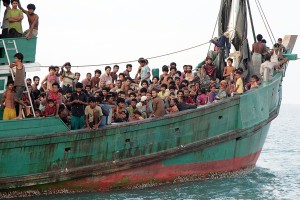Migrant Crisis in Asia
Wednesday, May 20th, 2015May 20, 2015
Government officials from three Southeast Asian countries—Indonesia, Malaysia, and Thailand—met today in Malaysia’s capital, Kuala Lumpur, and agreed to stop turning away migrant ships from their coasts. At least 3,500 migrants from Bangladesh and Myanmar have come ashore in one of the three nations over the last few weeks, but some 7,000 more migrants are thought to be still adrift at sea. The migrants are in distress from their long journeys and many of them are dehydrated and malnourished.

Migrants wait to be rescued by fishermen off the coast of Aceh, Indonesia, May 20, 2015. Hundreds of migrants stranded at sea for months were rescued and taken to Indonesia, officials reported, the latest in a stream of Rohingya and Bangladeshi migrants to reach shore in a growing crisis confronting Southeast Asia. Credit: AP Photo
Refugees from Bangladesh are mostly economic migrants seeking jobs. The migrants from Myanmar, however, are Rohingya Muslims, a group that has long been persecuted in Myanmar. Rohingya, even those from families who have lived in Myanmar for generations, are denied citizenship in the predominantly Buddhist nation and have few rights there.
The current migrant boat crisis in Southeast Asia began a few weeks ago. Previously, migrants from Bangladesh and Myanmar had traveled by sea to Thailand and then overland. Thailand recently cracked down on this overland traffic, and now smugglers are sending migrants exclusively on sea routes. Often these human traffickers abandon the migrants if a ship founders. Navies from Indonesia, Malaysia, and Thailand have been turning away the boat people at their shores and have sometimes towed stricken boats to the shores of other nations.
The agreement to permit migrants to enter the host nations by sea solves a humanitarian crisis in the short run. Eventually, however, the solution lies in helping Bangladesh to become more economically sound and pressuring Myanmar to recognize and stop persecuting the Rohingya population living in its borders.
Other World Book articles:


